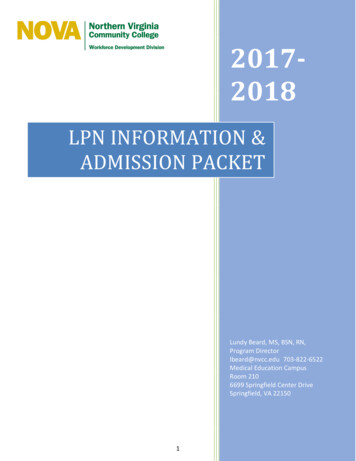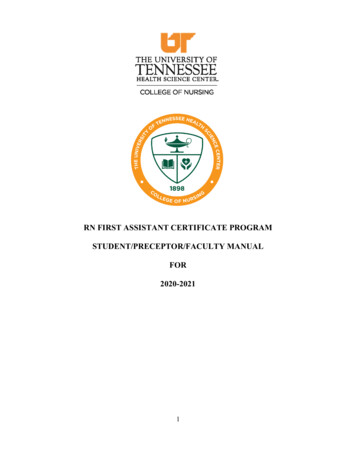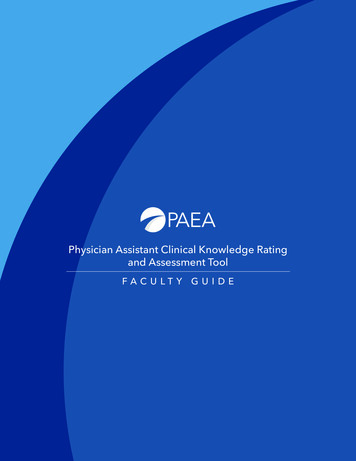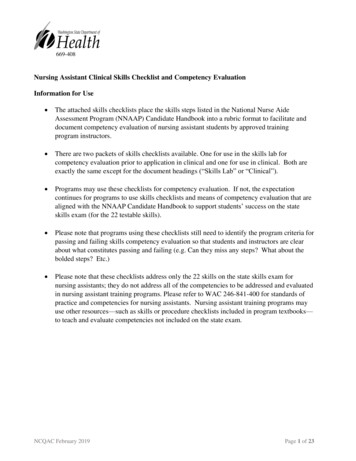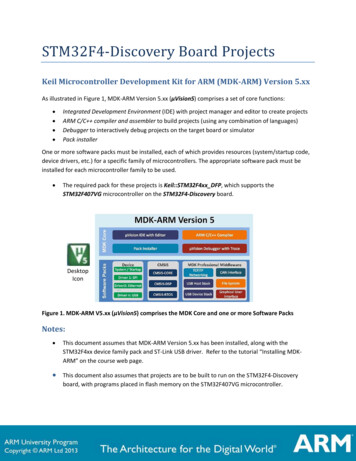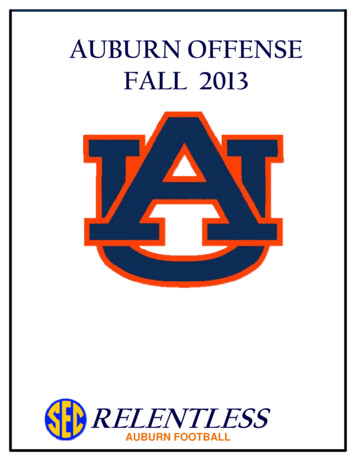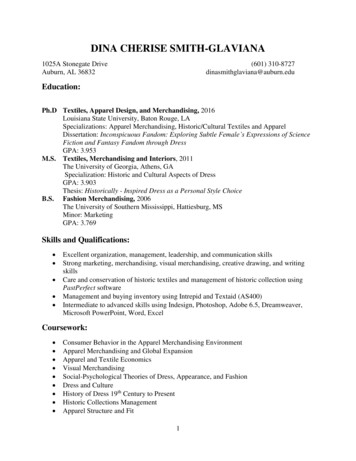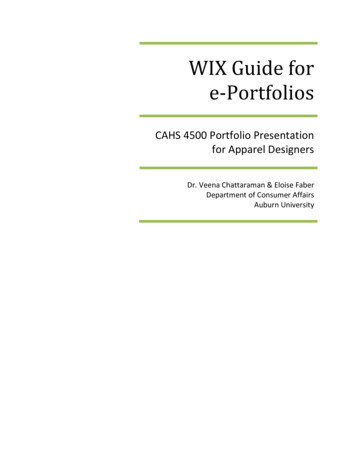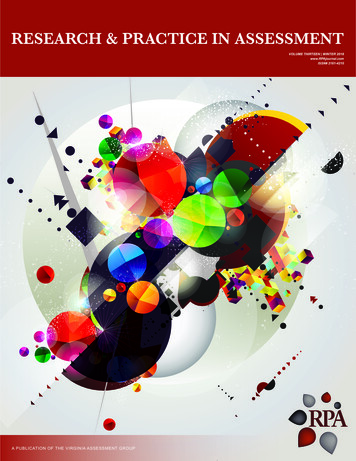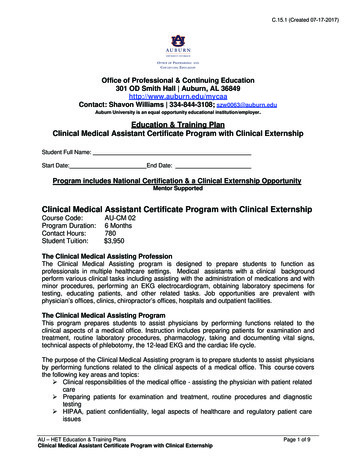
Transcription
C.15.1 (Created 07-17-2017)AUBUR NO FFICE OF P ROFESSIONAL ANDCONTINUING EDUCATIONOffice of Professional & Continuing Education301 OD Smith Hall Auburn, AL 36849http://www.auburn.edu/mycaaContact: Shavon Williams 334-844-3108; szw0063@auburn.eduAuburn University is an equal opportunity educational institution/employer.Education & Training PlanClinical Medical Assistant Certificate Program with Clinical ExternshipStudent Full Name:End Date:Start Date:Program includes National Certification & a Clinical Externship OpportunityMentor SupportedClinical Medical Assistant Certificate Program with Clinical ExternshipCourse Code:Program Duration:Contact Hours:Student Tuition:AU-CM 026 Months780 3,950The Clinical Medical Assisting ProfessionThe Clinical Medical Assisting program is designed to prepare students to function asprofessionals in multiple healthcare settings. Medical assistants with a clinical backgroundperform various clinical tasks including assisting with the administration of medications and withminor procedures, performing an EKG electrocardiogram, obtaining laboratory specimens fortesting, educating patients, and other related tasks. Job opportunities are prevalent withphysician’s offices, clinics, chiropractor’s offices, hospitals and outpatient facilities.The Clinical Medical Assisting ProgramThis program prepares students to assist physicians by performing functions related to theclinical aspects of a medical office. Instruction includes preparing patients for examination andtreatment, routine laboratory procedures, pharmacology, taking and documenting vital signs,technical aspects of phlebotomy, the 12-lead EKG and the cardiac life cycle.The purpose of the Clinical Medical Assisting program is to prepare students to assist physiciansby performing functions related to the clinical aspects of a medical office. This course coversthe following key areas and topics: Clinical responsibilities of the medical office - assisting the physician with patient relatedcare Preparing patients for examination and treatment, routine procedures and diagnostictesting HIPAA, patient confidentiality, legal aspects of healthcare and regulatory patient careissuesAU – HET Education & Training PlansClinical Medical Assistant Certificate Program with Clinical ExternshipPage 1 of 9
C1 (Created 9/3/15) Recording and taking of vital signs, blood pressure, and other patient care items relatedto the physician office visit Review and administration of medications, allergies & other pharmacology related items Laboratory procedures, phlebotomy and the proper techniques required to collectspecimens for laboratory analysis Cardiology and the proper placement of leads when taking a 12 lead EKGEducation and National Certifications Students should have or be pursuing a high school diploma or GED. There are no state approval and/or state requirements associated with this program. There are several National Certification exams that are available to students whosuccessfully complete this program:o National Healthcareer Association (NHA) Certified Clinical MedicalAssistant (CCMA) Examo American Society of Phlebotomy Technician(ASPT) PhlebotomyTechnician (CPT) Examo National Healthcareer Association (NHA) Certified Phlebotomy Technician(CPT) Examo National Healthcareer Association (NHA) Certified EKG Technician (CET)exam In addition to facilitating entry-level clinical medical assisting related positions, thiscourse is ideal for students interested in pursuing a future formal Certified MedicalAssistant (CMA), Nursing (LPN) or a Nursing (RN) program.Clinical Medical Assisting Detailed Course Information: Responsibilities of the clinical medical assistant and introduction to healthcare facilities Medical terminology, anatomy and physiology, circulation of the heart and blood vessels Care & safety of patients, medical & legal aspects of care, confidentiality and HIPAA Effective verbal and non-verbal communication, interpersonal skills and human behavior Aseptic techniques, infection prevention, universal precautions, proper use and disposalof biohazards and sharps Documenting patient medical histories, updating patient medical files, vital signs anddocumentation Appling sterile dressings, preparing patients for x-rays, performing various injections,administering oral medications, instructing patients on the proper usage of medications Phlebotomy, venipunctures and capillary sampling, collecting specimens and point ofcare testing Performing 12 lead EKGs and EKG strip analysis (P,Q,R,S,T wave form) Role of the EKG technician Function of the EKG department in a variety of settings (hospital, clinic, office, mobileservice) Medical terminology related to electrocardiography Care and safety of patients including medical and legal aspects of patient care Anatomy and physiology of the cardiovascular system Electrophysiology, the conduction system of the heart, and the cardiac cycle Circulation of blood through the heart and vessels Lead placement for 12-lead electrocardiography Basic EKG interpretation of normal rhythms and arrhythmias EKG troubleshooting including recognizing artifacts Waves and measurements EKG strip analysis (P,Q,R,S,T wave-form interpretation) Identification of rhythms using the 12-lead EKGAU – HET Education & Training PlansClinical Medical Assistant Certificate Program with Clinical ExternshipPage 2 of 9
C1 (Created 9/3/15) PacemakersHolter monitoring and the echocardiogramThe history of Phlebotomy and the roles and responsibilities of a Phlebotomy TechnicianLaboratory operations (e.g. safety, quality control,), quality assurance , laboratory law,ethics and regulatory issuesAnatomy and physiology of the circulatory system and anatomy of the hand, leg & foot –including arteries and veinsUniversal precautions – safety protocols, infection control and medical asepsisSpecimen collection, processing, handling, documentation and transportationVenipuntcures and skin puncture practice, syringe practice, heel puncture, protocol,syringe draws, etc.National CertificationUpon successful completion of this Auburn University Clinical Medical Assistant program,students would be eligible to sit for the National Healthcareer Association (NHA) CertifiedClinical Medical Assistant (CCMA) national certification exam as well as other EKG andPhlebotomy Technician exams. Although there are no state approval, state registration or otherstate requirements for this program, students who complete this Clinical Medical Assistantprogram at Auburn University will be prepared and are eligible to sit for this national certificationexam. Students who complete this program are encouraged to complete the clinical externshipoption with their program. Students who complete this program can and do sit for the NHACCMA national certification exam and are qualified, eligible and prepared to do so. AuburnUniversity works with each student to complete the exam application and register the student totake their national certification exam.Clinical Externship / Hands on Training / PracticumAlthough not a requirement of this program, once students complete the Clinical MedicalAssistant program they have the ability to participate in a clinical externship and/or hands onpracticum so as to practice the skills necessary to perform the job requirements of a ClinicalMedical Assistant. Students will be assisted with completing a resume and/or otherrequirements necessary to work in a hospital, physicians practice, clinic and/or with otherhealthcare organizations. All students who complete this program are eligible to participate inan externship and will be placed in a healthcare organization near their location. AuburnUniversity works with national healthcare organizations and has the ability to place students inclinical externship opportunities nationwide.Auburn University contact: If students have any questions regarding the Clinical MedicalAssistant program including national certification and clinical externships, they should callShavon Williams of Auburn University at 334-844-3108 or via emailat szw0063@auburn.eduNote: No refunds can be issued after the start date published in your Financial Award document.AU – HET Education & Training PlansClinical Medical Assistant Certificate Program with Clinical ExternshipPage 3 of 9
C1 (Created 9/3/15)About Auburn University!Welcome to Auburn University! Auburn University was established in 1856 as the EastAlabama Male College, 20 years after the city of Auburn's founding.OUR MISSION: The Office of Professional and Continuing Education (OPCE) makes theeducational resources of Auburn University available for non-credit education programs andconferences designed to promote lifelong learning, regardless of age, interest, or location. Ourprograms fall into five general categories: Professional Development, Certificate Programs,Personal Enrichment, Summer Youth Programs, andConferences. http://www.auburn.edu/mycaaPEARSONEducationAuburn University and Pearson EducationThe Auburn University’s Office of Professional and Continuing Education eLearning programswere developed in partnership with Pearson Education to produce the highest quality, best-inclass content and delivery necessary to enhance the overall student learning experience, boostunderstanding and ensure retention. Pearson Education is the premier content and learningcompany in North America offering solutions to the higher education and career trainingdivisions of colleges and universities across the country aimed at driving quality educationprograms to ensure student success. Please visit us at www.pearson.com.About Pearson EducationWelcome to Pearson. We have a simple mission: to help people make more of their livesthrough learning. We are the world's leading learning company, with 40,000 employees in morethan 80 countries helping people of all ages to make measurable progress in their lives. Weprovide a range of education products and services to institutions, governments and direct toindividual learners, that help people everywhere aim higher and fulfil their true potential. Ourcommitment to them requires a holistic approach to education. It begins by using research tounderstand what sort of learning works best, it continues by bringing together people andorganizations to develop ideas, and it comes back round by measuring the outcomes of ourproducts.AU – HET Education & Training PlansClinical Medical Assistant Certificate Program with Clinical ExternshipPage 4 of 9
C1 (Created 9/3/15)Lesson ChecklistEach lesson has a prescribed, detailed checklist of activities for successful completion of thelesson. This includes lesson objectives, readings, and recommended assignments. Althoughassignments are optional, the instructor will grade and provide feedback on submittedassignments.Course Materials: Clinical Medical Assisting: Foundations and Practice EKG Technician Program Standard, Custom Edition Package - Book package includesEKG Technician Program PowerPoint Slides EKG Technician Program Standard Student Workbook EKG Technician Program Advanced, Custom Edition Package - Book package includesEKG Technician Program: Advanced PowerPoint Slides Phlebotomy Handbook: Blood Specimen Collection From Basic to Advanced, 8e Phlebotomy Technician Program Student Workbook, Custom EditionModule/Lesson StructureThe Clinical Medical Assisting Program is divided into four main content modules. Each modulecontains lesson presentations to view. These lesson presentations are the “lectures” which,along with the textbook readings and resources, will help you learn the material. The lessonpresentations address a variety of learning styles and preferences using text, audio, video, etc.Each lesson contains at least one Check Your Understanding interactive self-assessment thatwill help you gauge your comprehension of that lesson’s content. Many lessons includesupplemental resources such as videos, learning activities, and flashcards. Using theseadditional materials will deepen your understanding of the content.Course OverviewCMA Module 1 – Introduction to the Clinical Medical Assisting Profession Lesson 1 The Medical Assisting Profession Reading Assignment: Chapter 1 (pp. 2-13) Lesson 2 Interpersonal Communication Reading Assignment: Chapter 2 (pp. 16-26) Lesson 3 Patient-Centered Care Reading Assignment: Chapter 3 (pp. 27-35) Reading Assignment: Chapter 4 (pp. 36-46)CMA Module 2 – The Clinical Environment Lesson 4 The Clinical Environment: Safety and the Patient Encounter Reading Assignment: Chapter 5 (pp. 48-59) Reading Assignment: Chapter 6 (pp. 60-77) Lesson 5 Medical and Surgical Asepsis Reading Assignment: Chapter 7 (pp. 78-94) Reading Assignment: Chapter 8 (pp. 95-115) Lesson 6 Pharmacology and Medication Administration Reading Assignment: Chapter 9 (pp. 116-146) Lesson 7 Vital Signs Reading Assignment: Chapter 10 (pp. 147-175) Lesson 8 Minor Surgery Reading Assignment: Chapter 11 (pp. 176-199)AU – HET Education & Training PlansClinical Medical Assistant Certificate Program with Clinical ExternshipPage 5 of 9
C1 (Created 9/3/15)CMA Module 3 – Medical Specialties and Testing Lesson 9 Medical Imaging Reading Assignment: Chapter 16 (pp. 306-323) Lesson 10 Pulmonary System and Testing Reading Assignment: Chapter 18 (pp. 363-385) Lesson 11 EENT Reading Assignment: Chapter 19 (pp. 386-413) Lesson 12 Immunology and Allergies Reading Assignment: Chapter 20 (pp. 414-425) Lesson 13 Dermatology Reading Assignment: Chapter 21 (pp. 426-445) Lesson 14 Endocrinology Reading Assignment: Chapter 22 (pp. 446-456)CMA Module 4 – Medical Specialties Lesson 15 Emergency Care Reading Assignment: Chapter 23 (pp. 458-498) Lesson 16 Gastroenterology and Nutrition Reading Assignment: Chapter 24 (pp. 499-528) Lesson 17 Orthopedics and Physical Therapy Reading Assignment: Chapter 25 (pp. 529-562) Lesson 18 Obstetrics and Gynecology Reading Assignment: Chapter 26 (pp. 563-588) Lesson 19 Pediatrics Reading Assignment: Chapter 27 (pp. 589-608) Lesson 20 Neurology Reading Assignment: Chapter 28 (pp. 609-626) Lesson 21 Mental Health Reading Assignment: Chapter 29 (pp. 627-643) Lesson 22 Oncology Reading Assignment: Chapter 30 (pp. 644-654) Lesson 23 Geriatrics Reading Assignment: Chapter 31 (pp. 655-665) Lesson 24 Alternative Medicine Reading Assignment: Chapter 32 (pp. 668-678)EKG Module 1 Lesson 1 – Coronary Anatomy and Physiology Reading Assignment: Chapter 1: pp. 1-12 Lesson 2 – Electrophysiology Reading Assignment: Chapter 2: pp. 13-34 Lesson 3 – A Review of Lead Morphology and Placement Reading Assignment: Chapter 3: pp. 35-46 Lesson 4 – The Technical Aspects of the EKG Reading Assignment: Chapter 4: pp. 47-60AU – HET Education & Training PlansClinical Medical Assistant Certificate Program with Clinical ExternshipPage 6 of 9
C1 (Created 9/3/15)EKG Module 2 Lesson 5 – Calculating the Heart Rate Reading Assignment: Chapter 5: pp. 61-72 Lesson 6 – How to Interpret a Rhythm Strip Reading Assignment: Chapter 6: pp. 73-78 Lesson 7 – A Review of Rhythms Originating from the Sinus Node Reading Assignment: Chapter 7: pp. 79-98 Lesson 8 – A Review of Rhythms Originating from the Atria Reading Assignment: Chapter 8: pp. 99-119EKG Module 3 Lesson 9 – A Review of Rhythms Originating in the Av Junction Reading Assignment: Chapter 9: pp. 121-132 Lesson 10 – Rhythms Originating on the Ventricles Reading Assignment: Chapter 10: pp. 133-155 Lesson 11 – AV Blocks Reading Assignment: Chapter 11: pp. 157-176 Lesson 12 – Performing Rhythms Practice Strips Reading Assignment: Chapter 12: pp. 177-302EKG Module 4 Lesson 13 – A Review of Artificial Pacemakers Reading Assignment: Chapter 13: pp. 303-317 Lesson 14 – Diagnostic Electrocardiography Reading Assignment: Chapter 14: pp. 319-345EKG Module 5 – Advanced Lesson 15 – How to Interpret a 12-Lead EKG Reading Assignment: Chapter 1: pp. 1-36 Lesson 16 – Myocardial Infarction Reading Assignment: Chapter 2: pp. 37-71 Lesson 17 – Cardiac Medications and Electrical Therapy Reading Assignment: Chapter 4: pp. 103-109PHLEBOTOMY Module 1 – Overview and Safety in Phlebotomy Procedures Lesson 1 – Phlebotomy Practice and Quality Management Reading Assignment: Chapter 1 (pp. 1-38)Lesson 2 – Communication, Computerization, and Documentation Reading Assignment: Chapter 2 (pp. 39-80)Lesson 3 – Professional Ethics, Legal, and Regulatory Issues Reading Assignment: Chapter 3 (pp. 81-100)Lesson 4 – Infection Control Reading Assignment: Chapter 4 (pp. 101-137)Lesson 5 – Safety and First Aid Reading Assignment: Chapter 5 (pp. 138-157)PHLEBOTOMY Module 2 – Overview of Medical Terminology, Anatomy, and Physiology Lesson 6 – Medical Terminology, Anatomy, and Physiology of Organ Systems Reading Assignment: Chapter 6 (pp. 158-173)Lesson 7 – Anatomy and Physiology of Organ Systems Reading Assignment: Chapter 6 (pp. 173-206)Lesson 8 – The Cardiovascular and Lymphatic Systems Reading Assignment: Chapter 7 (pp. 207-248)AU – HET Education & Training PlansClinical Medical Assistant Certificate Program with Clinical ExternshipPage 7 of 9
C1 (Created 9/3/15)PHLEBOTOMY Module 3 – Phlebotomy Specimen Collection Procedures Lesson 9 – Blood Collection Equipment Reading Assignment: Chapter 8 (pp. 249-280)Lesson 10 – Preanalytical Complications Causing Medical Errors in Blood Collection Reading Assignment: Chapter 9 (pp. 281-300)Lesson 11 – Venipuncture Procedures Reading Assignment: Chapter 10 (pp. 301-362)Lesson 12 – Capillary Blood Specimens Reading Assignment: Chapter 11 (pp. 363-382)Lesson 13 – Specimen Handling, Transportation, and Processing Reading Assignment: Chapter 12 (pp. 383-404)PHLEBOTOMY Module 4 – Point-of-Care Testing and Special Procedures Lesson 14 – Pediatric and Geriatric Procedures Reading Assignment: Chapter 13 (pp. 405-443)Lesson 15 – Point-of-Care Collections Reading Assignment: Chapter 14 (pp. 444-464)Lesson 16 – Arterial, Intravenous (IV), and Special Collection Procedures Reading Assignment: Chapter 15 (pp. 465-499)Lesson 17 – Urinalysis, Body Fluids, and Other Specimens Reading Assignment: Chapter 16 (pp. 500-522)Lesson 18 – Drug Use, Forensic Toxicology, Workplace Testing, Sports Medicine and RelatedAreas Reading Assignment: Chapter 17 (pp. 523-544)Note: This program can be completed in 6 months. However, students will have online access tothis program for a 24-month period.AU – HET Education & Training PlansClinical Medical Assistant Certificate Program with Clinical ExternshipPage 8 of 9
C1 (Created 9/3/15)MICROSOFT OFFICE Module Use an integrated software package, specifically the applications included in theMicrosoft Office suiteDemonstrate marketable skills for enhanced employment opportunitiesDescribe proper computer techniques for designing and producing various types ofdocumentsDemonstrate the common commands & techniques used in Windows desktopList the meaning of basic PC acronyms like MHz, MB, KB, HD and RAMUse WordPad and MSWord to create various types of documentsCreate headings and titles with Word ArtCreate and format spreadsheets, including the use of mathematical formulasDemonstrate a working knowledge of computer database functions, including putting,processing, querying and outputting dataDefine computer terminology in definition matching quizzesUse the Windows Paint program to alter graphicsUse a presentation application to create a presentation with both text and graphicsCopy data from one MS Office application to another application in the suiteUse e-mail and the Internet to send Word and Excel file attachmentsDemonstrate how to use the Windows Taskbar and Windows TooltipsExplain how copyright laws pertain to data and graphics posted on the InternetTake the college computer competency test after course completionNote: Although the Microsoft Office Module is not required to succes
Auburn University contact: If students have any questions regarding the Clinical Medical Assistant program including national certification and clinical externships, they should call Shavon Williams of Auburn University at 334-844-3

